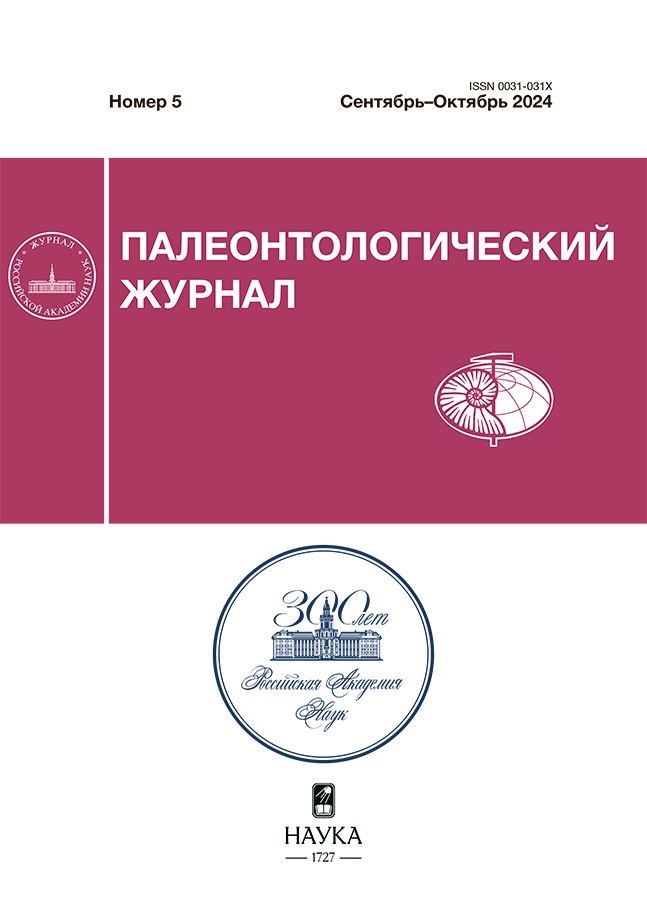Kolymopecten gen. nov. – a New Representative of Pectinoid Bivalves from the Lower–Middle Permian of the Boreal Superrealm
- 作者: Biakov A.S.1
-
隶属关系:
- North-East Interdisciplinary Scientific Research Institute n. a. N.A. Shilo, Far East Branch of the Russian Academy of Sciences
- 期: 编号 5 (2024)
- 页面: 3-14
- 栏目: Articles
- URL: https://archivog.com/0031-031X/article/view/684730
- DOI: https://doi.org/10.31857/S0031031X24050017
- EDN: https://elibrary.ru/QVDOTW
- ID: 684730
如何引用文章
详细
From the Lower-Middle Permian deposits of the Boreal Superrealm (Northeast Russia), a new genus of Permian pectinoid bivalves of the family Heteropectinidae – Kolymopecten gen. nov. with the type species K. kolymaensis (Maslennikow) is described. The genus also includes K. mutabilis (Licharew) and K. praekolymaensis sp. nov. All representatives of the new genus are quite simply constructed: their right weakly convex valve is ornamented with simple radial bifurcating ribs of two orders, and the left, much more convex valve is ornamented with intercalating ribs of up to five orders. The historical development of kolymopectens is briefly reviewed. Kolymopecten is one of the few “ancient” genera of Permian bivalves that survived the Late Kungurian regional faunal extinction, which affected all major benthic groups. Representatives of the genus are among the most widespread pectinoid bivalves in the Northeast of Russia, often forming mass accumulations, especially in the Artinskian-Kungurian deposits.
全文:
作者简介
A. Biakov
North-East Interdisciplinary Scientific Research Institute n. a. N.A. Shilo, Far East Branch of the Russian Academy of Sciences
编辑信件的主要联系方式.
Email: abiakov@mail.ru
俄罗斯联邦, Magadan, 685000
参考
- Астафьева М.М. Новые представители Aviculopectinidae (Bivalvia) // Палеонтол. журн. 1997. № 1. С. 24−29.
- Бяков А.С. Пермские биосферные события на Северо-Востоке Азии // Стратигр. Геол. корреляция. 2012а. T. 20. № 2. С. 88–100.
- Бяков А.С. Новая зональная схема пермских отложений Северо-Востока Азии по двустворчатым моллюскам. Статья 1. Зональное расчленение // Тихоокеан. геол. 2012б. Т. 31. № 5. С. 13–40.
- Каширцев А.С. Полевой атлас фауны пермских отложений Северо-Востока СССР. М., 1959. 85 с.
- Лихарев Б.К. Верхнекаменноугольные пелециподы Урала и Тимана // Тр. Геол. комитета. Нов. Сер. 1927. Вып. 164. 140 с.
- Лобанова О.В., Люткевич Е.М. Описание видов. Класс Bivalvia // Полевой атлас пермской фауны и флоры Северо-Востока СССР. Магадан: Магаданское кн. изд-во, 1970. С. 42–63.
- Люткевич Е.М., Лобанова О.В. Пелециподы перми советского сектора Арктики // Тр. ВНИГРИ. 1960. Вып. 149. 294 с.
- Люткевич Е.М., Лобанова О.В. Верхнепермские пластинчатожаберные моллюски бассейна р. Гижиги // Вопросы палеонтологии. Т. 6. Л.: ЛГУ, 1971. С. 73–96.
- Муромцева В.А. Двустворчатые моллюски карбона Казахстана и Сибири. Л.: Недра, 1974. 150 с. (Тр. ВНИГРИ. Вып. 336).
- Муромцева В.А., Гуськов В.А. Пермские морские отложения и двустворчатые моллюски Советской Арктики. Л.: Недра, 1984. 208 с.
- Biakov A.S. Permian bivalve mollusks of Northeast Asia // J. Asian Earth Sci. 2006. V. 26. № 3–4. P. 235–242.
- Biakov A.S. A new family and genus of late Permian pectinids of the Boreal superrealm (Pectinida: Voluceropectinidae: Voluceropecten) // Paleontol. J. 2024. V. 58. № 2. P. 151–159.
- Carter J.G., Altaba C.R., Anderson L.C. et al. A synoptical classification of the Bivalvia (Mollusca) // Paleontol. Contrib. 2011. № 4. P. 1–48.
- Fang Z.-J., Morris N.J. On the genera Aviculopecten and Heteropecten // Acta Palaeontol. Sin. 1999. V. 38. № 2. P. 148–155.
- Kegel W., Costa M.T. Especies neopaleozoicas do Brasil, da familia Aviculopectinidae, ornamentadoas com costelas fasciculadas // Brasil Depart. Nacional Producão Mineral, Divisão de Geol. e Mineral. 1951. V. 137. P. 1–48.
- Nakazawa K. Permian bivalves from West Spitsbergen, Svalbard Islands, Norway // Paleontol. Res. 1999. V. 3. № 1. P. 1–17.
- Newell N.D., Boyd D.W. Pectinoid bivalves of the Permian-Triassic crisis // Bull. Amer. Mus. Natur. Hist. 1995. V. 227. 95 p.
- Waterhouse J.B. Permian Pectinacea and Limacea (Bivalvia) from New Zealand // N.Z. Geol. Surv. Paleontol. Bull. 1982. № 49. 75 p.
- Waterhouse J.B. Aspects of the evolutionary record for fossils of the bivalve subclass Pteriomorphia Beurlen // Earthwise. 2008. V. 8. 220 p.
- Waterhouse J.B. New Late Paleozoic brachiopods and molluscs // Earthwise. 2010. V. 9. 134 p.
- Waterhouse J.B. Early Permian Conulariida, Brachiopoda and Mollusca from Homevale, Central Queensland // Earthwise. 2014. V. 11. 390 p.
补充文件












